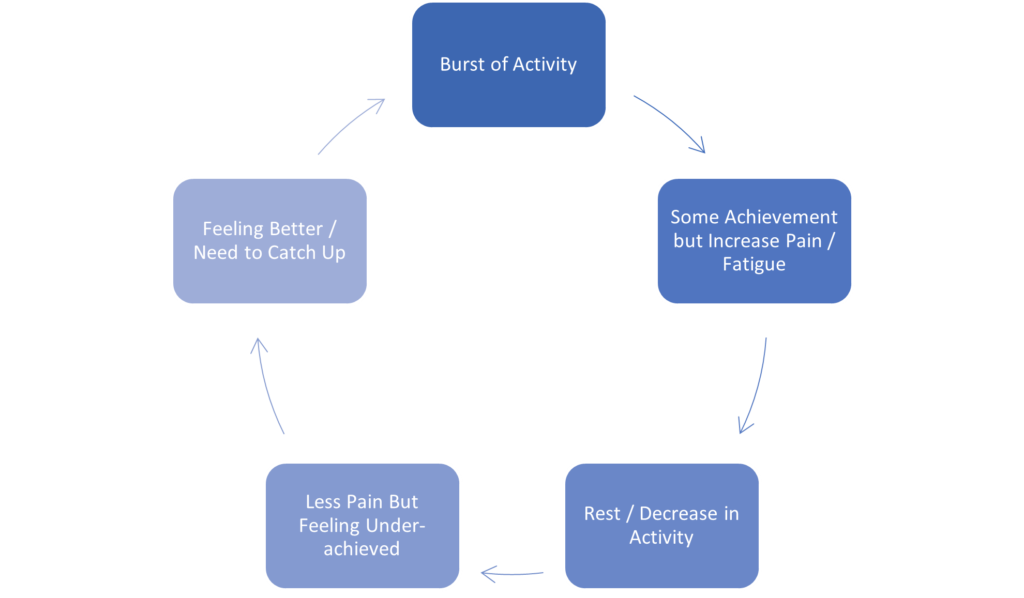By Sam Catherall – Exercise Physiologist
It is a very common scenario: you are recovering from an injury or illness and after some time, start to feel a bit better, so you rush out and try to hit the ground running, maybe returning to a level of activity that you were able to do previously. You could do it previously, so you try and return to that level of activity, only to end up paying for it later. You take appropriate rest until again you start to feel better, only to go out and do it all again. Unfortunately, this cycle may repeat itself several times before you realise what is happening. You have fallen into what we call the boom bust cycle.
When recovering from conditions such as Post-Viral Fatigue Syndrome, Chronic Fatigue Syndrome / Myalgic Encephalomyelitis and more recently Long-Covid, it is important to identify your activity habits that may be provoking your symptoms and essentially prolonging your recovery. Planned pacing has shown to be an effective strategy for not only energy & fatigue depriving conditions, but also for ongoing persistent pain, helping individuals gain more control of their life.

Figure 1: Boom / Bust Cycle
So, what is GOOD pacing? ✅
Pacing your activity is a strategy that helps you understand your body and its limits. Pace planning can aid in symptom limitation through choosing what to do and what not to do. It can help immensely in terms of avoiding downward spirals in physical activity, cognitive capacity, and the capacity to work.
In a nutshell, pacing is the implementation of a pre-planned strategy with the aim of maximising activity whilst avoiding set-backs due to over exertion. This can include physical, cognitive and emotional exertion.
Where to start? 📍
Goal setting
This is the most important aspect of setting good groundwork for your pacing strategy. What is important to you, why are we doing this? This needs to be something meaningful to you, as it will help build an effective strategy. If your answer it Everything, then we may need to break it down a little further.
Objectifying and Recording
Often tedious but reflecting (honestly) on what you can currently do is an important measure we need to observe. Choose an activity that is important to you. How long can you do that activity before symptoms are exacerbated? Do you push through those symptoms to get the task done? How long do you need to recover to baseline? Completing an activity diary is a great way to reflect on patterns or routines that you may have developed without realising. This helps you and your health care provider decipher the steps to take to better pace your activities.
Set baselines
Once you can reflect on your current routine, you should be able to identify any patterns with your activity and how your body responds. If you notice that you start to fatigue 30 minutes into cleaning the house, your baseline for cleaning the house will need to be LESS than this.
Plan activity & plan REST
It is not pacing when:
- “I do a task until I get pain or fatigue, then I rest” – if you are active until the point of pain, you have been active for too long.
- “I do all my tasks in the morning when I’m feeling better and reserve the afternoon for rest” – wearing yourself out in the morning ensures the need for rest in the afternoon, and maintains the boom bust cycle.
- “I wash the car until it is finished, I used to wash 2 in a row without rest” – using the completion of task will result in over doing it.
Good pacing should utilise time rather than the completion of the task. If you know your capacity for a task is 15 minutes without symptoms, but the task itself requires longer than this. You need to break the task into short bouts of 15 minutes with planned rest in between. Start with a 1:1 work rest ratio. You can slowly increase the work ratio by 10%, or decrease the rest ratio by 10% over several days, as long as symptoms don’t exacerbate.
Although it takes (a lot of) patience, small progressions allow your body to adapt appropriately to changes without large setbacks. The hardest part about implementing a good pacing strategy is being patient and gentle with your body and its limits. The best pacing plans are individualised and take into consideration your important factors such as goals, history, stress and the latest evidence-based practice for your specific injury/condition.
For help with this process, talk to an exercise physiologist who are experts in developing effective pacing strategies for individuals with a variety of complex health conditions.


